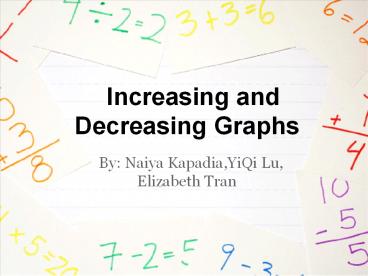Increasing and Decreasing Graphs - PowerPoint PPT Presentation
1 / 9
Title:
Increasing and Decreasing Graphs
Description:
Increasing and Decreasing Graphs By: Naiya Kapadia,YiQi Lu, Elizabeth Tran - Increasing and decreasing lines are determined by the graph's slope, which can be found ... – PowerPoint PPT presentation
Number of Views:297
Avg rating:3.0/5.0
Title: Increasing and Decreasing Graphs
1
Increasing and Decreasing Graphs
- By Naiya Kapadia,YiQi Lu, Elizabeth Tran
2
Linear Function
- - Increasing and decreasing lines are determined
by the graph's slope, which can be found in the
linear equation form, y mxb.
- To tell whether the graph is an increasing
function, the slope must be positive, and the
graph runs from left to right, as shown in the
"increasing graph."
Increasing Graph
Decreasing Graph
- To tell whether the graph is a decreasing
function,the slope must be negative, and the
graph runs from right to left, as shown in the
"decreasing graph."
y -1/4
3
Quadratic Function
- -
A quadratic function has the form y ax2 bx
c , where "a" cannot equal 0.
Increasing Graph
- To tell whether the graph is an increasing
function, a gt 0 and the graph opens upward. This
causes the "x" term of the graph to be positive ,
as shown in the "increasing graph."
Decreasing Graph
- To tell whether the graph is a decreasing
function, a lt 0 and the graph opens downward.
This causes the "x" term of the graph to be
negative, as shown in the "decreasing graph."
4
Correlation
- Also known as the "best fitting lines",
correlation helps show the linear relationship of
(a) set(s) of data.
- To tell whether a correlation graph is
increasing, the slope must be positive, gradually
progressing from the bottom left to the top right
of the grid, such as the example of the
"increasing graph."
Decreasing Graph
Increasing Graph
- To tell whether a correlation graph is
increasing, the slope must be negative, gradually
progressing from the top left to the bottom right
of the grid, such as the example of the
"decreasing graph."
5
Exponential Function
- Decreasing
- y abx is an exponential decay function when a
gt 0 and 0 lt b lt 1, which is a decreasing
function. - With an exponential decay graph, the graph would
be a curve line that decreases from the top of
left down to the right, which is a curve line of
decreasing - y a(1-r)t can use for a real-life quatity
decreases by a fixed percent each year.
- Increasing
- y abx is an exponential growth function when
a gt 0 and b gt 1, which is an increasing function. - This is a graph of exponential growth
function,the graph has a curving line that is
going from the bottom of left up to right, that
is an increasing line. - To apply the exponential growth function into
real life, you can use y a(1r)t for a real
life quantity increases by a fixed percent each
year.
6
Radical Function
- -y avX and y a 3vX (3vX is a cubic root) are
radical functions. - - If a gt 1, then it would be an increasing
- function for both y avX and y a 3vX
-
-
y a 3vX
y avX - - If a lt 1, then it would be a decreasing
- function for both y -avX and y -a 3vX
-
y -a 3vX
y -avX
7
Logarithmic Function Graph
- -Logarithmic Functions y logb(x - h) k
- For a logarithmic function to increase,
- the "b" value must be greater than 1.
- The graph is moving up to the right.
-
an increasing graph
-
A decreasing logarithmic function -
has a "b" value that is 0 lt b lt 1. The -
graph moves down to the right. - a decreasing graph
8
Absolute Value
Increasing graph
- - Put into the form of yax-hk
- -The "a" value is almost like the slope. It can
be either positive or negative. - - If the "a" value is positive, the graph opens
upwards as shown in the "increasing graph". - -If the "a" value is negative, the graph opens
downwards as shown in the "decreasing graph".
Decreasing graph
9
Piecewise Function
- - A function represented by a combination of
equations, each corresponding to a part of the
domain. - - The equations can be linear, quadratic,
polynomial...etc., as long as they have x-value
constraints. - - The equation of the original graph tells you if
the graph is decreasing or increasing or doing
both at certain points on the graph. The slope is
what determines this aspect of the graph, but the
constraint of the domain can change that. Look at
example.
Example of a piecewise function
Notice that the slope of the first equation is
positive, but the graph is going down. This is
because the constraint is making the graph look
like it's decreasing from that point of -3. The
second equation is a negative and stays negative
even after the constraint.












![Construction and Interpretation of Simple Diagrams and Graphs [I] PowerPoint PPT Presentation](https://s3.amazonaws.com/images.powershow.com/7658618.th0.jpg?_=20160307021)


















